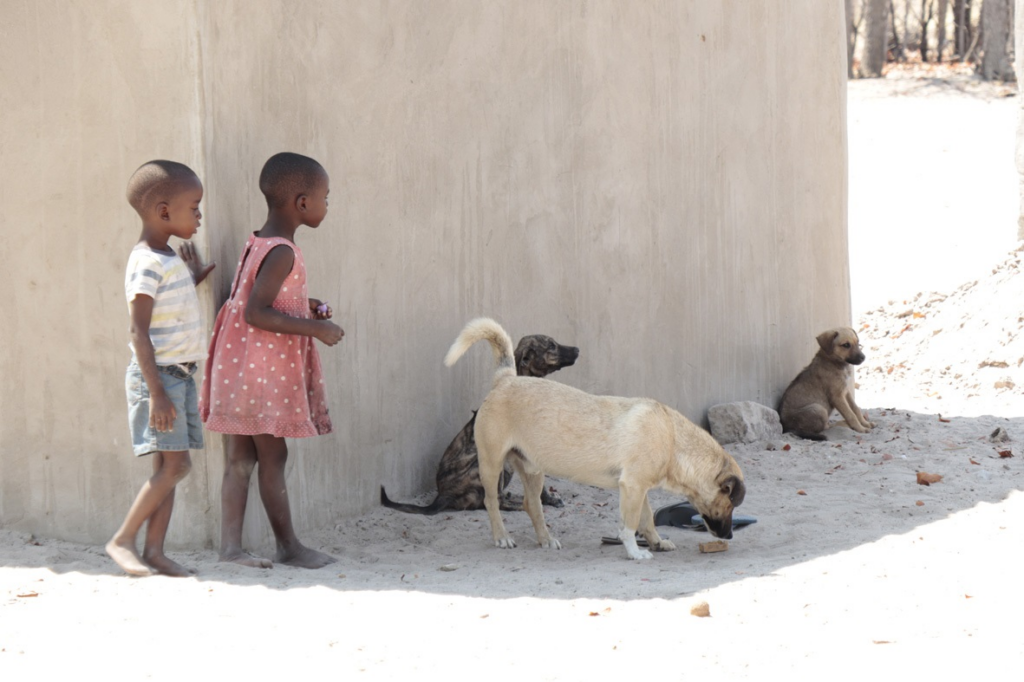Rabies is a vaccine-preventable, zoonotic, viral disease affecting the central nervous system. Once clinical symptoms appear, rabies is virtually 100% fatal. In up to 99% of cases, domestic dogs are responsible for rabies virus transmission to humans. Yet, rabies can affect both domestic and wild animals. It spreads to people and animals via saliva, usually through bites, scratches or direct contact with mucosa (e.g. eyes, mouth or open wounds). Children between the age of 5 and 14 years are frequent victims.
Rabies is present on all continents except Antarctica, with over 95% of human deaths occurring in Asia and Africa. However, rabies cases are rarely reported and registered numbers differ greatly from the estimated burden.
Rabies is one of the neglected tropical diseases (NTD) that predominantly affects already marginalized, poor and vulnerable populations. Although effective human vaccines and immunoglobulins exist for rabies, these are often not readily available or accessible to those in need. Managing a rabies exposure, where the average cost of rabies post-exposure prophylaxis (PEP) is currently estimated at an average of US$ 108 (along with travel costs and loss of income) can be a catastrophic financial burden on affected families whose average daily income may be as low as US$ 1–2 per person.
Every year, more than 29 million people worldwide receive PEP. This is estimated to prevent hundreds of thousands of rabies deaths annually. Globally, the economic burden of dog-mediated rabies is estimated at US$ 8.6 billion per year, in addition to uncalculated psychological trauma for individuals and communities.
Rabies is a vaccine-preventable disease. Vaccinating dogs, including puppies, is the most cost-effective strategy for preventing rabies in people because it stops the transmission at its source. Moreover, dog vaccination reduces the need for PEP.
Education on dog behaviour and bite prevention for both children and adults is an essential extension of rabies vaccination programmes and can decrease both the incidence of human rabies and the financial burden of treating dog bites.
Very effective vaccines are available to immunize people after an exposure (as PEP) or before an exposure to rabies. Pre-exposure prophylaxis (PrEP) is recommended for people in certain high-risk occupations (such as laboratory workers handling live rabies and rabies-related viruses) and people whose professional or personal activities might lead to direct contact with bats or other mammals that may be infected with rabies (such as animal disease control staff and wildlife rangers).
PrEP might be indicated also for outdoor travellers and people living in remote, highly rabies-endemic areas with limited local access to rabies biologics.
The incubation period for rabies is typically 2–3 months but may vary from 1 week to 1 year, depending on factors such as the location of virus entry and the viral load. Initial symptoms of rabies include generic signs like fever, pain and unusual or unexplained tingling, pricking, or burning sensations at the wound site. As the virus moves to the central nervous system, progressive and fatal inflammation of the brain and spinal cord develops. Clinical rabies in people can be managed but very rarely cured, and not without severe neurological deficits.
There are two forms of rabies:
Current diagnostic tools are not suitable for detecting rabies infection before the onset of clinical disease. Unless the rabies-specific signs of hydrophobia or aerophobia are present, or a reliable history of contact with a suspected or confirmed rabid animal is available, clinical diagnosis is difficult. Human rabies can be confirmed intra-vitam and post mortem by various diagnostic techniques that detect whole viruses, viral antigens, or nucleic acids in infected tissues (brain, skin or saliva).
People are usually infected following a deep bite or scratch from an animal with rabies, which is, in 99% of the cases, a dog. Transmission can also occur if saliva of infected animals comes into direct contact with mucosa (e.g. eyes or mouth) or fresh skin wounds.
In the Americas, hematophagous bats are now the major source of human rabies deaths as dog-mediated transmission has been largely interrupted in this region. Bat-mediated rabies is also an emerging public health threat in Australia and western Europe.
Human deaths following exposure to foxes, raccoons, skunks, jackals, mongooses and other wild carnivore host species are very rare, and bites from rodents are not known to transmit rabies.
Contraction of rabies through inhalation of virus-containing aerosols or through transplantation of infected organs has been described, but is extremely rare. Human-to-human transmission through bites or saliva is theoretically possible but has never been confirmed. The same applies to the transmission to humans via consumption of raw meat or milk of infected animals.
Post-exposure prophylaxis (PEP) is the emergency response to a rabies exposure. This prevents the virus from entering the central nervous system, which would invariably result in death. PEP consists of:
Depending on the severity of the contact with the suspected rabid animal, administration of a full PEP course is recommended as follows:
Category II and III exposures require PEP.
WHO recommends administering rabies vaccines intradermally, as this reduces the amount of necessary vaccine and therefore the cost by 60–80% without compromising any safety or efficacy.
Rabies is included in WHO’s 2021–2030 Roadmap for the global control of neglected tropical diseases, which sets regional, progressive targets for the elimination of targeted diseases. Rabies is one of these. As a zoonotic disease, it requires close cross-sectoral coordination at the national, regional and global levels.
The key towards implementing effective rabies elimination programs is to engage with local communities, start small, catalyse long-term investment through stimulus packages, ensure the ownership of governments, demonstrate success and cost-effectiveness, and scale up quickly.
Rabies elimination is feasible and achievable if this goal is prioritized and adequately supported financially and politically.
Related
News
More
- WHO Expert Consultation on Rabies: WHO TRS N°1012
- Frequently asked questions about rabies for the general public
- Frequently asked questions about rabies for clinicians
- Zero by 30: the global strategic plan to end human deaths from dog-mediated rabies by 2030
- Rabies vaccines: WHO position paper – April 2018
- Scientific and operational updates on rabies
- World Organisation for Animal Health (WOAH) Rabies portal
- Ending the neglect to attain the Sustainable Development Goals: A road map for neglected tropical diseases 2021–2030

